2004 CHRYSLER VOYAGER sensor
[x] Cancel search: sensorPage 2521 of 2585
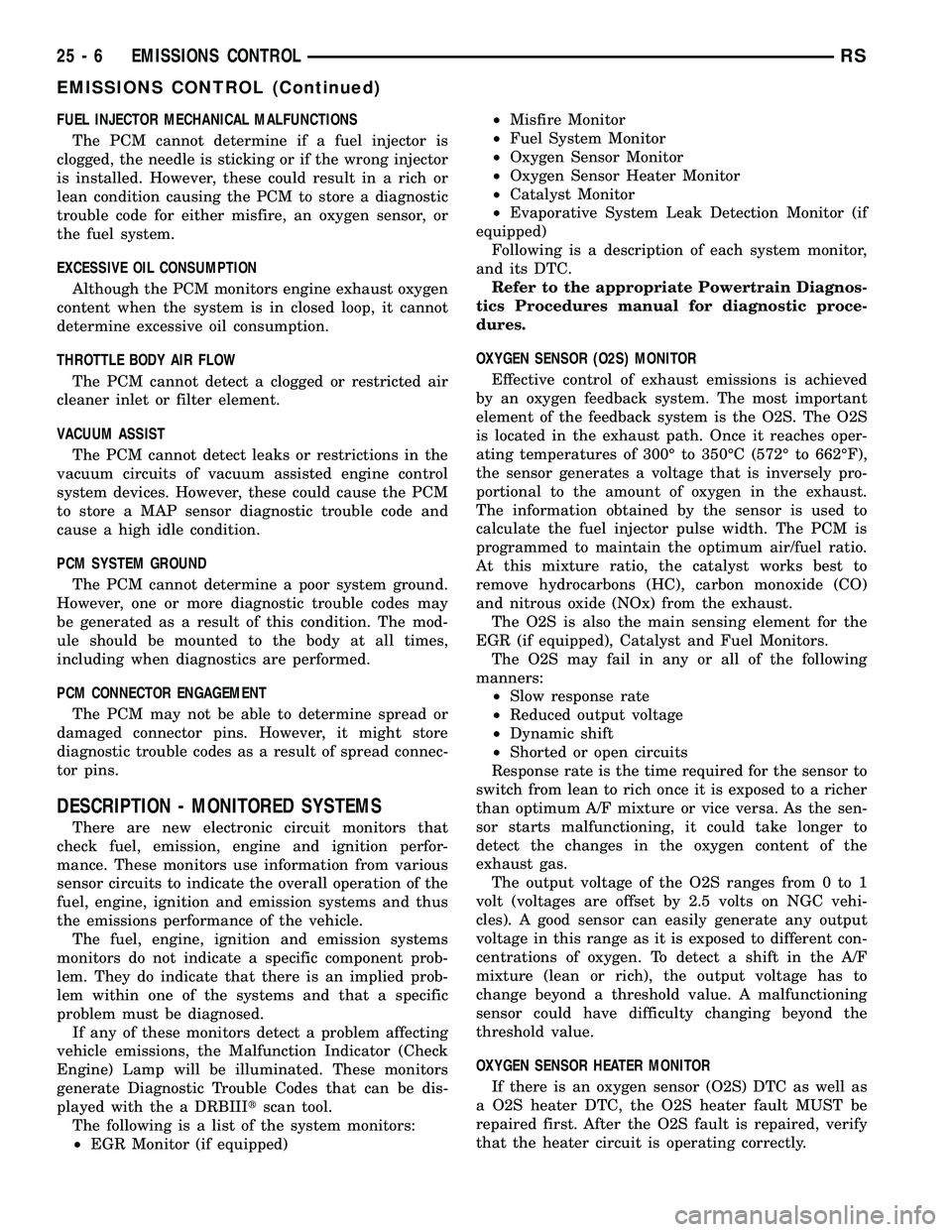
FUEL INJECTOR MECHANICAL MALFUNCTIONS
The PCM cannot determine if a fuel injector is
clogged, the needle is sticking or if the wrong injector
is installed. However, these could result in a rich or
lean condition causing the PCM to store a diagnostic
trouble code for either misfire, an oxygen sensor, or
the fuel system.
EXCESSIVE OIL CONSUMPTION
Although the PCM monitors engine exhaust oxygen
content when the system is in closed loop, it cannot
determine excessive oil consumption.
THROTTLE BODY AIR FLOW
The PCM cannot detect a clogged or restricted air
cleaner inlet or filter element.
VACUUM ASSIST
The PCM cannot detect leaks or restrictions in the
vacuum circuits of vacuum assisted engine control
system devices. However, these could cause the PCM
to store a MAP sensor diagnostic trouble code and
cause a high idle condition.
PCM SYSTEM GROUND
The PCM cannot determine a poor system ground.
However, one or more diagnostic trouble codes may
be generated as a result of this condition. The mod-
ule should be mounted to the body at all times,
including when diagnostics are performed.
PCM CONNECTOR ENGAGEMENT
The PCM may not be able to determine spread or
damaged connector pins. However, it might store
diagnostic trouble codes as a result of spread connec-
tor pins.
DESCRIPTION - MONITORED SYSTEMS
There are new electronic circuit monitors that
check fuel, emission, engine and ignition perfor-
mance. These monitors use information from various
sensor circuits to indicate the overall operation of the
fuel, engine, ignition and emission systems and thus
the emissions performance of the vehicle.
The fuel, engine, ignition and emission systems
monitors do not indicate a specific component prob-
lem. They do indicate that there is an implied prob-
lem within one of the systems and that a specific
problem must be diagnosed.
If any of these monitors detect a problem affecting
vehicle emissions, the Malfunction Indicator (Check
Engine) Lamp will be illuminated. These monitors
generate Diagnostic Trouble Codes that can be dis-
played with the a DRBIIItscan tool.
The following is a list of the system monitors:
²EGR Monitor (if equipped)²Misfire Monitor
²Fuel System Monitor
²Oxygen Sensor Monitor
²Oxygen Sensor Heater Monitor
²Catalyst Monitor
²Evaporative System Leak Detection Monitor (if
equipped)
Following is a description of each system monitor,
and its DTC.
Refer to the appropriate Powertrain Diagnos-
tics Procedures manual for diagnostic proce-
dures.
OXYGEN SENSOR (O2S) MONITOR
Effective control of exhaust emissions is achieved
by an oxygen feedback system. The most important
element of the feedback system is the O2S. The O2S
is located in the exhaust path. Once it reaches oper-
ating temperatures of 300É to 350ÉC (572É to 662ÉF),
the sensor generates a voltage that is inversely pro-
portional to the amount of oxygen in the exhaust.
The information obtained by the sensor is used to
calculate the fuel injector pulse width. The PCM is
programmed to maintain the optimum air/fuel ratio.
At this mixture ratio, the catalyst works best to
remove hydrocarbons (HC), carbon monoxide (CO)
and nitrous oxide (NOx) from the exhaust.
The O2S is also the main sensing element for the
EGR (if equipped), Catalyst and Fuel Monitors.
The O2S may fail in any or all of the following
manners:
²Slow response rate
²Reduced output voltage
²Dynamic shift
²Shorted or open circuits
Response rate is the time required for the sensor to
switch from lean to rich once it is exposed to a richer
than optimum A/F mixture or vice versa. As the sen-
sor starts malfunctioning, it could take longer to
detect the changes in the oxygen content of the
exhaust gas.
The output voltage of the O2S ranges from 0 to 1
volt (voltages are offset by 2.5 volts on NGC vehi-
cles). A good sensor can easily generate any output
voltage in this range as it is exposed to different con-
centrations of oxygen. To detect a shift in the A/F
mixture (lean or rich), the output voltage has to
change beyond a threshold value. A malfunctioning
sensor could have difficulty changing beyond the
threshold value.
OXYGEN SENSOR HEATER MONITOR
If there is an oxygen sensor (O2S) DTC as well as
a O2S heater DTC, the O2S heater fault MUST be
repaired first. After the O2S fault is repaired, verify
that the heater circuit is operating correctly.
25 - 6 EMISSIONS CONTROLRS
EMISSIONS CONTROL (Continued)
Page 2522 of 2585
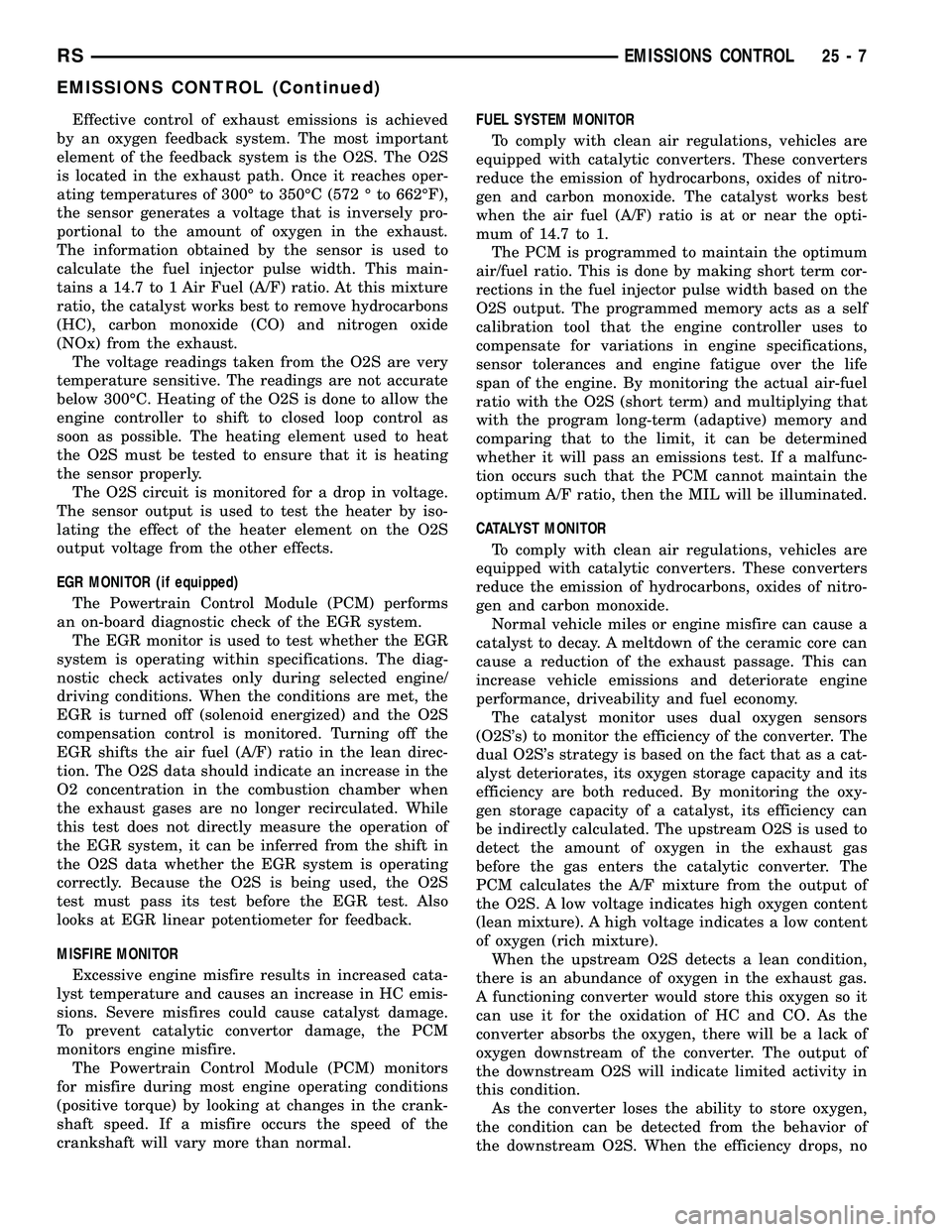
Effective control of exhaust emissions is achieved
by an oxygen feedback system. The most important
element of the feedback system is the O2S. The O2S
is located in the exhaust path. Once it reaches oper-
ating temperatures of 300É to 350ÉC (572 É to 662ÉF),
the sensor generates a voltage that is inversely pro-
portional to the amount of oxygen in the exhaust.
The information obtained by the sensor is used to
calculate the fuel injector pulse width. This main-
tains a 14.7 to 1 Air Fuel (A/F) ratio. At this mixture
ratio, the catalyst works best to remove hydrocarbons
(HC), carbon monoxide (CO) and nitrogen oxide
(NOx) from the exhaust.
The voltage readings taken from the O2S are very
temperature sensitive. The readings are not accurate
below 300ÉC. Heating of the O2S is done to allow the
engine controller to shift to closed loop control as
soon as possible. The heating element used to heat
the O2S must be tested to ensure that it is heating
the sensor properly.
The O2S circuit is monitored for a drop in voltage.
The sensor output is used to test the heater by iso-
lating the effect of the heater element on the O2S
output voltage from the other effects.
EGR MONITOR (if equipped)
The Powertrain Control Module (PCM) performs
an on-board diagnostic check of the EGR system.
The EGR monitor is used to test whether the EGR
system is operating within specifications. The diag-
nostic check activates only during selected engine/
driving conditions. When the conditions are met, the
EGR is turned off (solenoid energized) and the O2S
compensation control is monitored. Turning off the
EGR shifts the air fuel (A/F) ratio in the lean direc-
tion. The O2S data should indicate an increase in the
O2 concentration in the combustion chamber when
the exhaust gases are no longer recirculated. While
this test does not directly measure the operation of
the EGR system, it can be inferred from the shift in
the O2S data whether the EGR system is operating
correctly. Because the O2S is being used, the O2S
test must pass its test before the EGR test. Also
looks at EGR linear potentiometer for feedback.
MISFIRE MONITOR
Excessive engine misfire results in increased cata-
lyst temperature and causes an increase in HC emis-
sions. Severe misfires could cause catalyst damage.
To prevent catalytic convertor damage, the PCM
monitors engine misfire.
The Powertrain Control Module (PCM) monitors
for misfire during most engine operating conditions
(positive torque) by looking at changes in the crank-
shaft speed. If a misfire occurs the speed of the
crankshaft will vary more than normal.FUEL SYSTEM MONITOR
To comply with clean air regulations, vehicles are
equipped with catalytic converters. These converters
reduce the emission of hydrocarbons, oxides of nitro-
gen and carbon monoxide. The catalyst works best
when the air fuel (A/F) ratio is at or near the opti-
mum of 14.7 to 1.
The PCM is programmed to maintain the optimum
air/fuel ratio. This is done by making short term cor-
rections in the fuel injector pulse width based on the
O2S output. The programmed memory acts as a self
calibration tool that the engine controller uses to
compensate for variations in engine specifications,
sensor tolerances and engine fatigue over the life
span of the engine. By monitoring the actual air-fuel
ratio with the O2S (short term) and multiplying that
with the program long-term (adaptive) memory and
comparing that to the limit, it can be determined
whether it will pass an emissions test. If a malfunc-
tion occurs such that the PCM cannot maintain the
optimum A/F ratio, then the MIL will be illuminated.
CATALYST MONITOR
To comply with clean air regulations, vehicles are
equipped with catalytic converters. These converters
reduce the emission of hydrocarbons, oxides of nitro-
gen and carbon monoxide.
Normal vehicle miles or engine misfire can cause a
catalyst to decay. A meltdown of the ceramic core can
cause a reduction of the exhaust passage. This can
increase vehicle emissions and deteriorate engine
performance, driveability and fuel economy.
The catalyst monitor uses dual oxygen sensors
(O2S's) to monitor the efficiency of the converter. The
dual O2S's strategy is based on the fact that as a cat-
alyst deteriorates, its oxygen storage capacity and its
efficiency are both reduced. By monitoring the oxy-
gen storage capacity of a catalyst, its efficiency can
be indirectly calculated. The upstream O2S is used to
detect the amount of oxygen in the exhaust gas
before the gas enters the catalytic converter. The
PCM calculates the A/F mixture from the output of
the O2S. A low voltage indicates high oxygen content
(lean mixture). A high voltage indicates a low content
of oxygen (rich mixture).
When the upstream O2S detects a lean condition,
there is an abundance of oxygen in the exhaust gas.
A functioning converter would store this oxygen so it
can use it for the oxidation of HC and CO. As the
converter absorbs the oxygen, there will be a lack of
oxygen downstream of the converter. The output of
the downstream O2S will indicate limited activity in
this condition.
As the converter loses the ability to store oxygen,
the condition can be detected from the behavior of
the downstream O2S. When the efficiency drops, no
RSEMISSIONS CONTROL25-7
EMISSIONS CONTROL (Continued)
Page 2523 of 2585
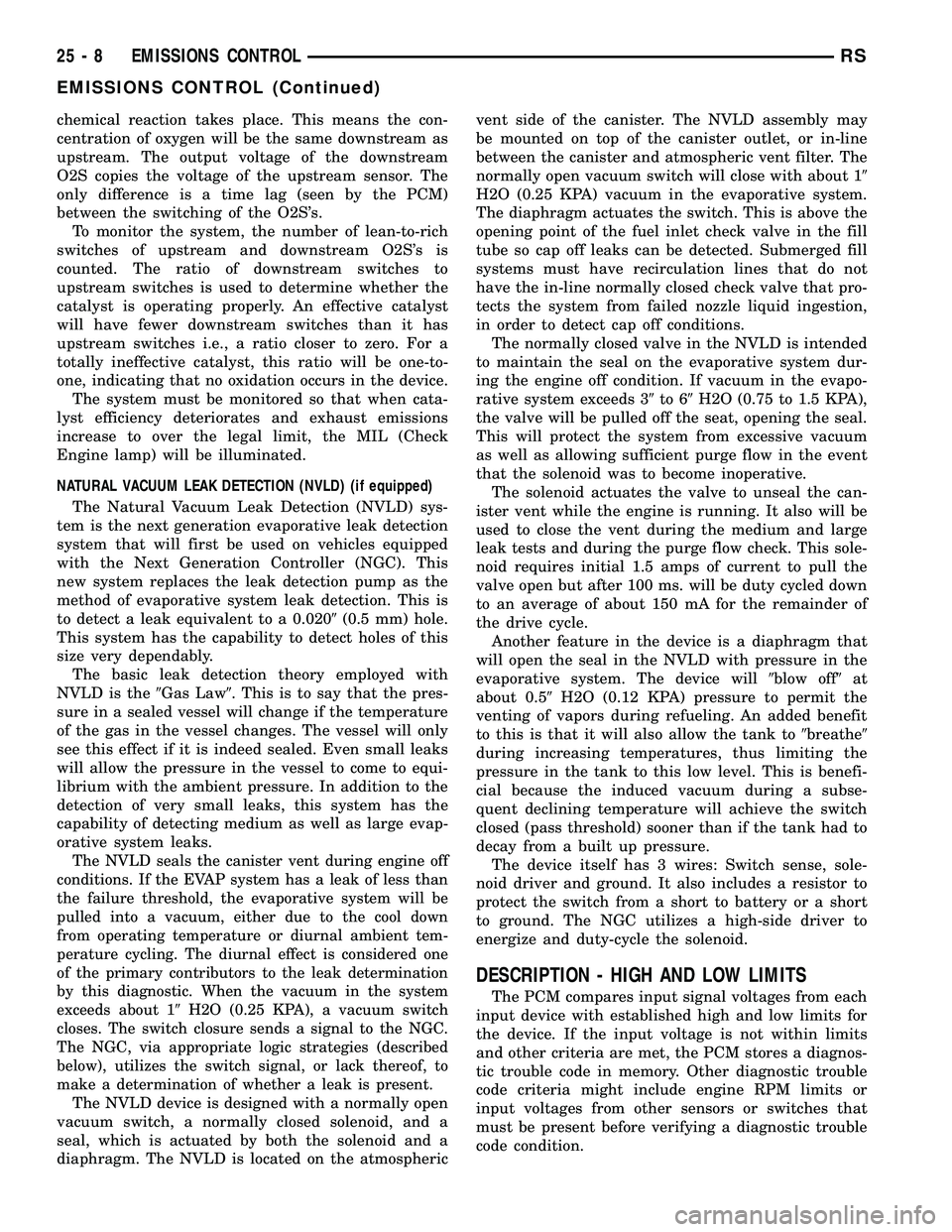
chemical reaction takes place. This means the con-
centration of oxygen will be the same downstream as
upstream. The output voltage of the downstream
O2S copies the voltage of the upstream sensor. The
only difference is a time lag (seen by the PCM)
between the switching of the O2S's.
To monitor the system, the number of lean-to-rich
switches of upstream and downstream O2S's is
counted. The ratio of downstream switches to
upstream switches is used to determine whether the
catalyst is operating properly. An effective catalyst
will have fewer downstream switches than it has
upstream switches i.e., a ratio closer to zero. For a
totally ineffective catalyst, this ratio will be one-to-
one, indicating that no oxidation occurs in the device.
The system must be monitored so that when cata-
lyst efficiency deteriorates and exhaust emissions
increase to over the legal limit, the MIL (Check
Engine lamp) will be illuminated.
NATURAL VACUUM LEAK DETECTION (NVLD) (if equipped)
The Natural Vacuum Leak Detection (NVLD) sys-
tem is the next generation evaporative leak detection
system that will first be used on vehicles equipped
with the Next Generation Controller (NGC). This
new system replaces the leak detection pump as the
method of evaporative system leak detection. This is
to detect a leak equivalent to a 0.0209(0.5 mm) hole.
This system has the capability to detect holes of this
size very dependably.
The basic leak detection theory employed with
NVLD is the9Gas Law9. This is to say that the pres-
sure in a sealed vessel will change if the temperature
of the gas in the vessel changes. The vessel will only
see this effect if it is indeed sealed. Even small leaks
will allow the pressure in the vessel to come to equi-
librium with the ambient pressure. In addition to the
detection of very small leaks, this system has the
capability of detecting medium as well as large evap-
orative system leaks.
The NVLD seals the canister vent during engine off
conditions. If the EVAP system has a leak of less than
the failure threshold, the evaporative system will be
pulled into a vacuum, either due to the cool down
from operating temperature or diurnal ambient tem-
perature cycling. The diurnal effect is considered one
of the primary contributors to the leak determination
by this diagnostic. When the vacuum in the system
exceeds about 19H2O (0.25 KPA), a vacuum switch
closes. The switch closure sends a signal to the NGC.
The NGC, via appropriate logic strategies (described
below), utilizes the switch signal, or lack thereof, to
make a determination of whether a leak is present.
The NVLD device is designed with a normally open
vacuum switch, a normally closed solenoid, and a
seal, which is actuated by both the solenoid and a
diaphragm. The NVLD is located on the atmosphericvent side of the canister. The NVLD assembly may
be mounted on top of the canister outlet, or in-line
between the canister and atmospheric vent filter. The
normally open vacuum switch will close with about 19
H2O (0.25 KPA) vacuum in the evaporative system.
The diaphragm actuates the switch. This is above the
opening point of the fuel inlet check valve in the fill
tube so cap off leaks can be detected. Submerged fill
systems must have recirculation lines that do not
have the in-line normally closed check valve that pro-
tects the system from failed nozzle liquid ingestion,
in order to detect cap off conditions.
The normally closed valve in the NVLD is intended
to maintain the seal on the evaporative system dur-
ing the engine off condition. If vacuum in the evapo-
rative system exceeds 39to 69H2O (0.75 to 1.5 KPA),
the valve will be pulled off the seat, opening the seal.
This will protect the system from excessive vacuum
as well as allowing sufficient purge flow in the event
that the solenoid was to become inoperative.
The solenoid actuates the valve to unseal the can-
ister vent while the engine is running. It also will be
used to close the vent during the medium and large
leak tests and during the purge flow check. This sole-
noid requires initial 1.5 amps of current to pull the
valve open but after 100 ms. will be duty cycled down
to an average of about 150 mA for the remainder of
the drive cycle.
Another feature in the device is a diaphragm that
will open the seal in the NVLD with pressure in the
evaporative system. The device will9blow off9at
about 0.59H2O (0.12 KPA) pressure to permit the
venting of vapors during refueling. An added benefit
to this is that it will also allow the tank to9breathe9
during increasing temperatures, thus limiting the
pressure in the tank to this low level. This is benefi-
cial because the induced vacuum during a subse-
quent declining temperature will achieve the switch
closed (pass threshold) sooner than if the tank had to
decay from a built up pressure.
The device itself has 3 wires: Switch sense, sole-
noid driver and ground. It also includes a resistor to
protect the switch from a short to battery or a short
to ground. The NGC utilizes a high-side driver to
energize and duty-cycle the solenoid.
DESCRIPTION - HIGH AND LOW LIMITS
The PCM compares input signal voltages from each
input device with established high and low limits for
the device. If the input voltage is not within limits
and other criteria are met, the PCM stores a diagnos-
tic trouble code in memory. Other diagnostic trouble
code criteria might include engine RPM limits or
input voltages from other sensors or switches that
must be present before verifying a diagnostic trouble
code condition.
25 - 8 EMISSIONS CONTROLRS
EMISSIONS CONTROL (Continued)
Page 2524 of 2585
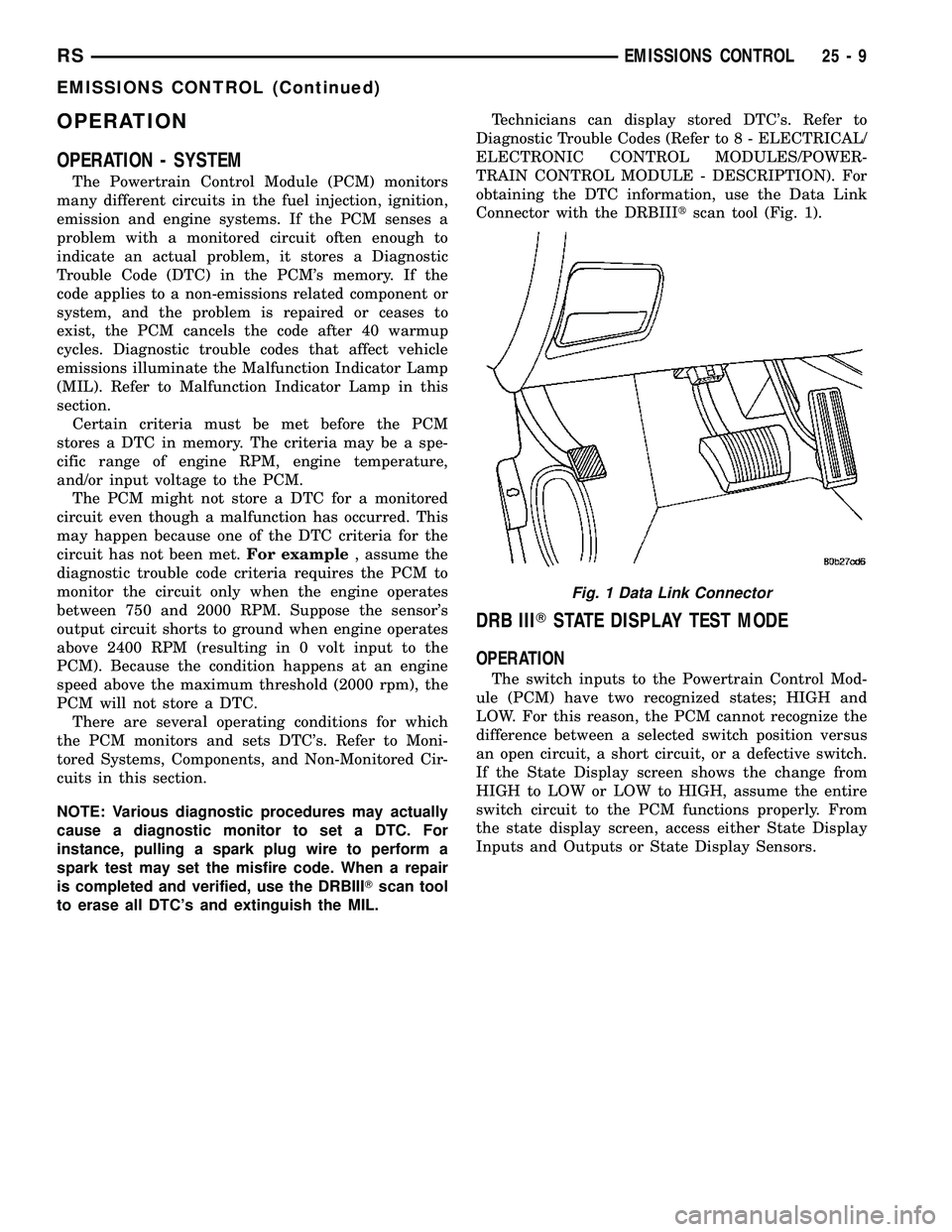
OPERATION
OPERATION - SYSTEM
The Powertrain Control Module (PCM) monitors
many different circuits in the fuel injection, ignition,
emission and engine systems. If the PCM senses a
problem with a monitored circuit often enough to
indicate an actual problem, it stores a Diagnostic
Trouble Code (DTC) in the PCM's memory. If the
code applies to a non-emissions related component or
system, and the problem is repaired or ceases to
exist, the PCM cancels the code after 40 warmup
cycles. Diagnostic trouble codes that affect vehicle
emissions illuminate the Malfunction Indicator Lamp
(MIL). Refer to Malfunction Indicator Lamp in this
section.
Certain criteria must be met before the PCM
stores a DTC in memory. The criteria may be a spe-
cific range of engine RPM, engine temperature,
and/or input voltage to the PCM.
The PCM might not store a DTC for a monitored
circuit even though a malfunction has occurred. This
may happen because one of the DTC criteria for the
circuit has not been met.For example, assume the
diagnostic trouble code criteria requires the PCM to
monitor the circuit only when the engine operates
between 750 and 2000 RPM. Suppose the sensor's
output circuit shorts to ground when engine operates
above 2400 RPM (resulting in 0 volt input to the
PCM). Because the condition happens at an engine
speed above the maximum threshold (2000 rpm), the
PCM will not store a DTC.
There are several operating conditions for which
the PCM monitors and sets DTC's. Refer to Moni-
tored Systems, Components, and Non-Monitored Cir-
cuits in this section.
NOTE: Various diagnostic procedures may actually
cause a diagnostic monitor to set a DTC. For
instance, pulling a spark plug wire to perform a
spark test may set the misfire code. When a repair
is completed and verified, use the DRBIIITscan tool
to erase all DTC's and extinguish the MIL.Technicians can display stored DTC's. Refer to
Diagnostic Trouble Codes (Refer to 8 - ELECTRICAL/
ELECTRONIC CONTROL MODULES/POWER-
TRAIN CONTROL MODULE - DESCRIPTION). For
obtaining the DTC information, use the Data Link
Connector with the DRBIIItscan tool (Fig. 1).
DRB IIITSTATE DISPLAY TEST MODE
OPERATION
The switch inputs to the Powertrain Control Mod-
ule (PCM) have two recognized states; HIGH and
LOW. For this reason, the PCM cannot recognize the
difference between a selected switch position versus
an open circuit, a short circuit, or a defective switch.
If the State Display screen shows the change from
HIGH to LOW or LOW to HIGH, assume the entire
switch circuit to the PCM functions properly. From
the state display screen, access either State Display
Inputs and Outputs or State Display Sensors.
Fig. 1 Data Link Connector
RSEMISSIONS CONTROL25-9
EMISSIONS CONTROL (Continued)
Page 2539 of 2585
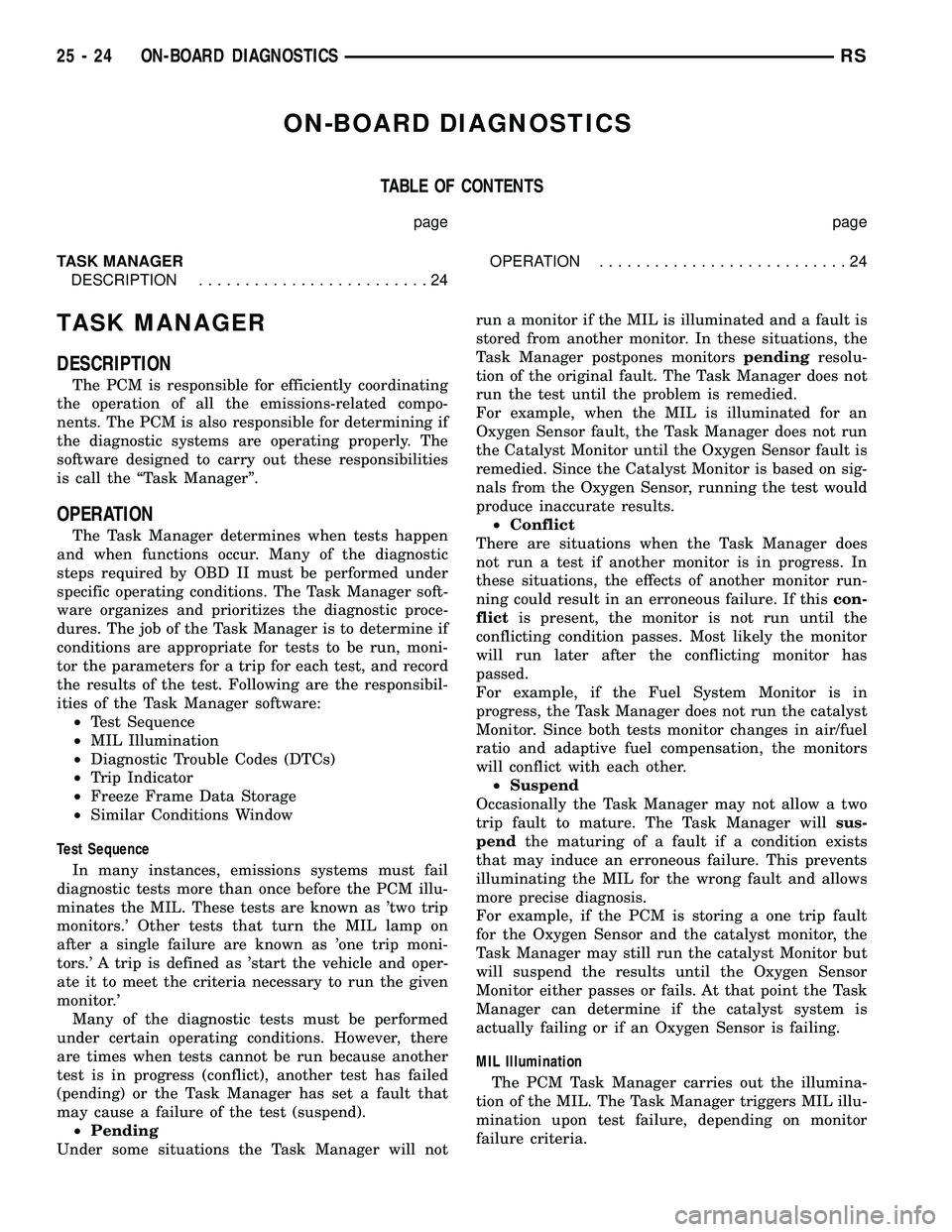
ON-BOARD DIAGNOSTICS
TABLE OF CONTENTS
page page
TASK MANAGER
DESCRIPTION.........................24OPERATION...........................24
TASK MANAGER
DESCRIPTION
The PCM is responsible for efficiently coordinating
the operation of all the emissions-related compo-
nents. The PCM is also responsible for determining if
the diagnostic systems are operating properly. The
software designed to carry out these responsibilities
is call the ªTask Managerº.
OPERATION
The Task Manager determines when tests happen
and when functions occur. Many of the diagnostic
steps required by OBD II must be performed under
specific operating conditions. The Task Manager soft-
ware organizes and prioritizes the diagnostic proce-
dures. The job of the Task Manager is to determine if
conditions are appropriate for tests to be run, moni-
tor the parameters for a trip for each test, and record
the results of the test. Following are the responsibil-
ities of the Task Manager software:
²Test Sequence
²MIL Illumination
²Diagnostic Trouble Codes (DTCs)
²Trip Indicator
²Freeze Frame Data Storage
²Similar Conditions Window
Test Sequence
In many instances, emissions systems must fail
diagnostic tests more than once before the PCM illu-
minates the MIL. These tests are known as 'two trip
monitors.' Other tests that turn the MIL lamp on
after a single failure are known as 'one trip moni-
tors.' A trip is defined as 'start the vehicle and oper-
ate it to meet the criteria necessary to run the given
monitor.'
Many of the diagnostic tests must be performed
under certain operating conditions. However, there
are times when tests cannot be run because another
test is in progress (conflict), another test has failed
(pending) or the Task Manager has set a fault that
may cause a failure of the test (suspend).
²Pending
Under some situations the Task Manager will notrun a monitor if the MIL is illuminated and a fault is
stored from another monitor. In these situations, the
Task Manager postpones monitorspendingresolu-
tion of the original fault. The Task Manager does not
run the test until the problem is remedied.
For example, when the MIL is illuminated for an
Oxygen Sensor fault, the Task Manager does not run
the Catalyst Monitor until the Oxygen Sensor fault is
remedied. Since the Catalyst Monitor is based on sig-
nals from the Oxygen Sensor, running the test would
produce inaccurate results.
²Conflict
There are situations when the Task Manager does
not run a test if another monitor is in progress. In
these situations, the effects of another monitor run-
ning could result in an erroneous failure. If thiscon-
flictis present, the monitor is not run until the
conflicting condition passes. Most likely the monitor
will run later after the conflicting monitor has
passed.
For example, if the Fuel System Monitor is in
progress, the Task Manager does not run the catalyst
Monitor. Since both tests monitor changes in air/fuel
ratio and adaptive fuel compensation, the monitors
will conflict with each other.
²Suspend
Occasionally the Task Manager may not allow a two
trip fault to mature. The Task Manager willsus-
pendthe maturing of a fault if a condition exists
that may induce an erroneous failure. This prevents
illuminating the MIL for the wrong fault and allows
more precise diagnosis.
For example, if the PCM is storing a one trip fault
for the Oxygen Sensor and the catalyst monitor, the
Task Manager may still run the catalyst Monitor but
will suspend the results until the Oxygen Sensor
Monitor either passes or fails. At that point the Task
Manager can determine if the catalyst system is
actually failing or if an Oxygen Sensor is failing.
MIL Illumination
The PCM Task Manager carries out the illumina-
tion of the MIL. The Task Manager triggers MIL illu-
mination upon test failure, depending on monitor
failure criteria.
25 - 24 ON-BOARD DIAGNOSTICSRS
Page 2541 of 2585
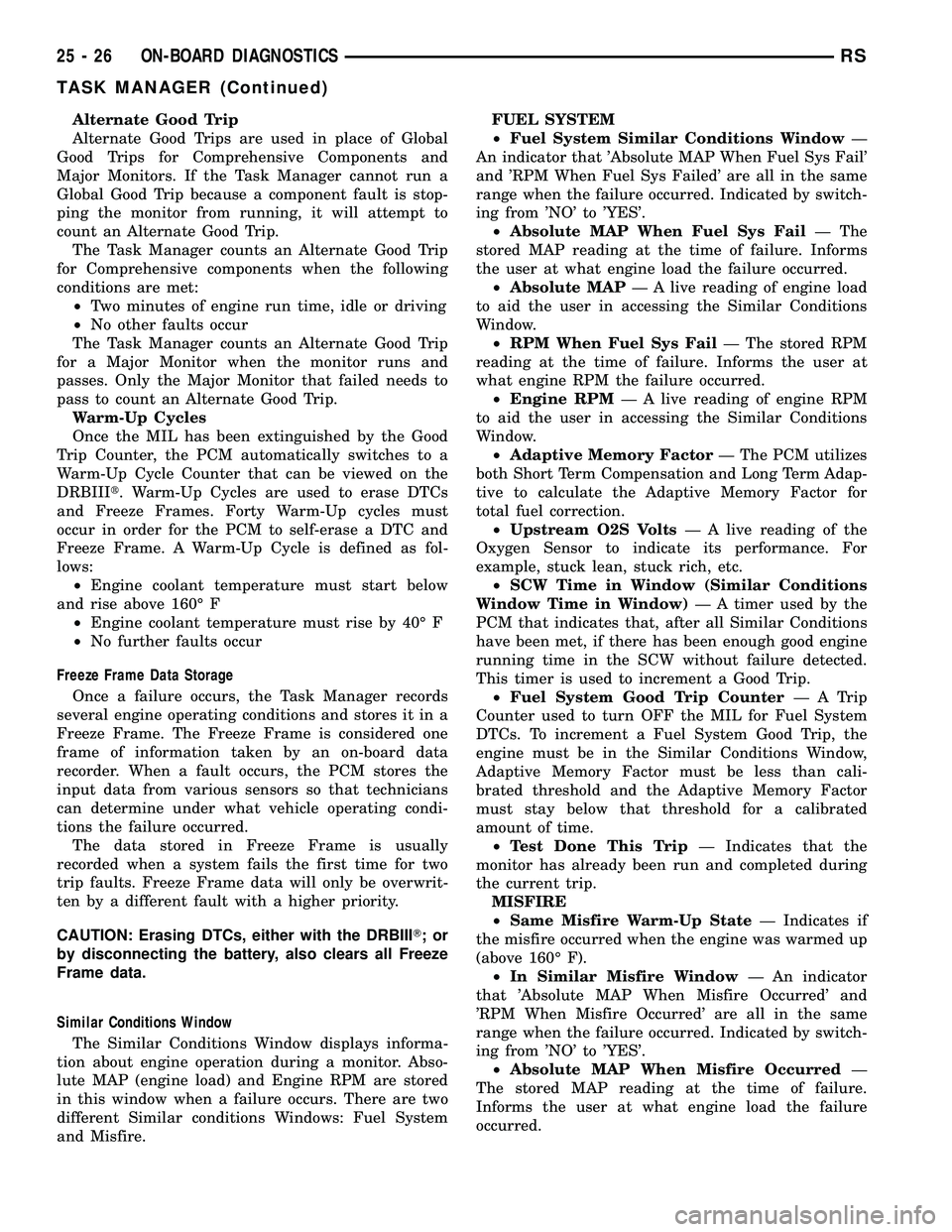
Alternate Good Trip
Alternate Good Trips are used in place of Global
Good Trips for Comprehensive Components and
Major Monitors. If the Task Manager cannot run a
Global Good Trip because a component fault is stop-
ping the monitor from running, it will attempt to
count an Alternate Good Trip.
The Task Manager counts an Alternate Good Trip
for Comprehensive components when the following
conditions are met:
²Two minutes of engine run time, idle or driving
²No other faults occur
The Task Manager counts an Alternate Good Trip
for a Major Monitor when the monitor runs and
passes. Only the Major Monitor that failed needs to
pass to count an Alternate Good Trip.
Warm-Up Cycles
Once the MIL has been extinguished by the Good
Trip Counter, the PCM automatically switches to a
Warm-Up Cycle Counter that can be viewed on the
DRBIIIt. Warm-Up Cycles are used to erase DTCs
and Freeze Frames. Forty Warm-Up cycles must
occur in order for the PCM to self-erase a DTC and
Freeze Frame. A Warm-Up Cycle is defined as fol-
lows:
²Engine coolant temperature must start below
and rise above 160É F
²Engine coolant temperature must rise by 40É F
²No further faults occur
Freeze Frame Data Storage
Once a failure occurs, the Task Manager records
several engine operating conditions and stores it in a
Freeze Frame. The Freeze Frame is considered one
frame of information taken by an on-board data
recorder. When a fault occurs, the PCM stores the
input data from various sensors so that technicians
can determine under what vehicle operating condi-
tions the failure occurred.
The data stored in Freeze Frame is usually
recorded when a system fails the first time for two
trip faults. Freeze Frame data will only be overwrit-
ten by a different fault with a higher priority.
CAUTION: Erasing DTCs, either with the DRBIIIT;or
by disconnecting the battery, also clears all Freeze
Frame data.
Similar Conditions Window
The Similar Conditions Window displays informa-
tion about engine operation during a monitor. Abso-
lute MAP (engine load) and Engine RPM are stored
in this window when a failure occurs. There are two
different Similar conditions Windows: Fuel System
and Misfire.FUEL SYSTEM
²Fuel System Similar Conditions WindowÐ
An indicator that 'Absolute MAP When Fuel Sys Fail'
and 'RPM When Fuel Sys Failed' are all in the same
range when the failure occurred. Indicated by switch-
ing from 'NO' to 'YES'.
²Absolute MAP When Fuel Sys FailÐ The
stored MAP reading at the time of failure. Informs
the user at what engine load the failure occurred.
²Absolute MAPÐ A live reading of engine load
to aid the user in accessing the Similar Conditions
Window.
²RPM When Fuel Sys FailÐ The stored RPM
reading at the time of failure. Informs the user at
what engine RPM the failure occurred.
²Engine RPMÐ A live reading of engine RPM
to aid the user in accessing the Similar Conditions
Window.
²Adaptive Memory FactorÐ The PCM utilizes
both Short Term Compensation and Long Term Adap-
tive to calculate the Adaptive Memory Factor for
total fuel correction.
²Upstream O2S VoltsÐ A live reading of the
Oxygen Sensor to indicate its performance. For
example, stuck lean, stuck rich, etc.
²SCW Time in Window (Similar Conditions
Window Time in Window)Ð A timer used by the
PCM that indicates that, after all Similar Conditions
have been met, if there has been enough good engine
running time in the SCW without failure detected.
This timer is used to increment a Good Trip.
²Fuel System Good Trip CounterÐATrip
Counter used to turn OFF the MIL for Fuel System
DTCs. To increment a Fuel System Good Trip, the
engine must be in the Similar Conditions Window,
Adaptive Memory Factor must be less than cali-
brated threshold and the Adaptive Memory Factor
must stay below that threshold for a calibrated
amount of time.
²Test Done This TripÐ Indicates that the
monitor has already been run and completed during
the current trip.
MISFIRE
²Same Misfire Warm-Up StateÐ Indicates if
the misfire occurred when the engine was warmed up
(above 160É F).
²In Similar Misfire WindowÐ An indicator
that 'Absolute MAP When Misfire Occurred' and
'RPM When Misfire Occurred' are all in the same
range when the failure occurred. Indicated by switch-
ing from 'NO' to 'YES'.
²Absolute MAP When Misfire OccurredÐ
The stored MAP reading at the time of failure.
Informs the user at what engine load the failure
occurred.
25 - 26 ON-BOARD DIAGNOSTICSRS
TASK MANAGER (Continued)
Page 2544 of 2585
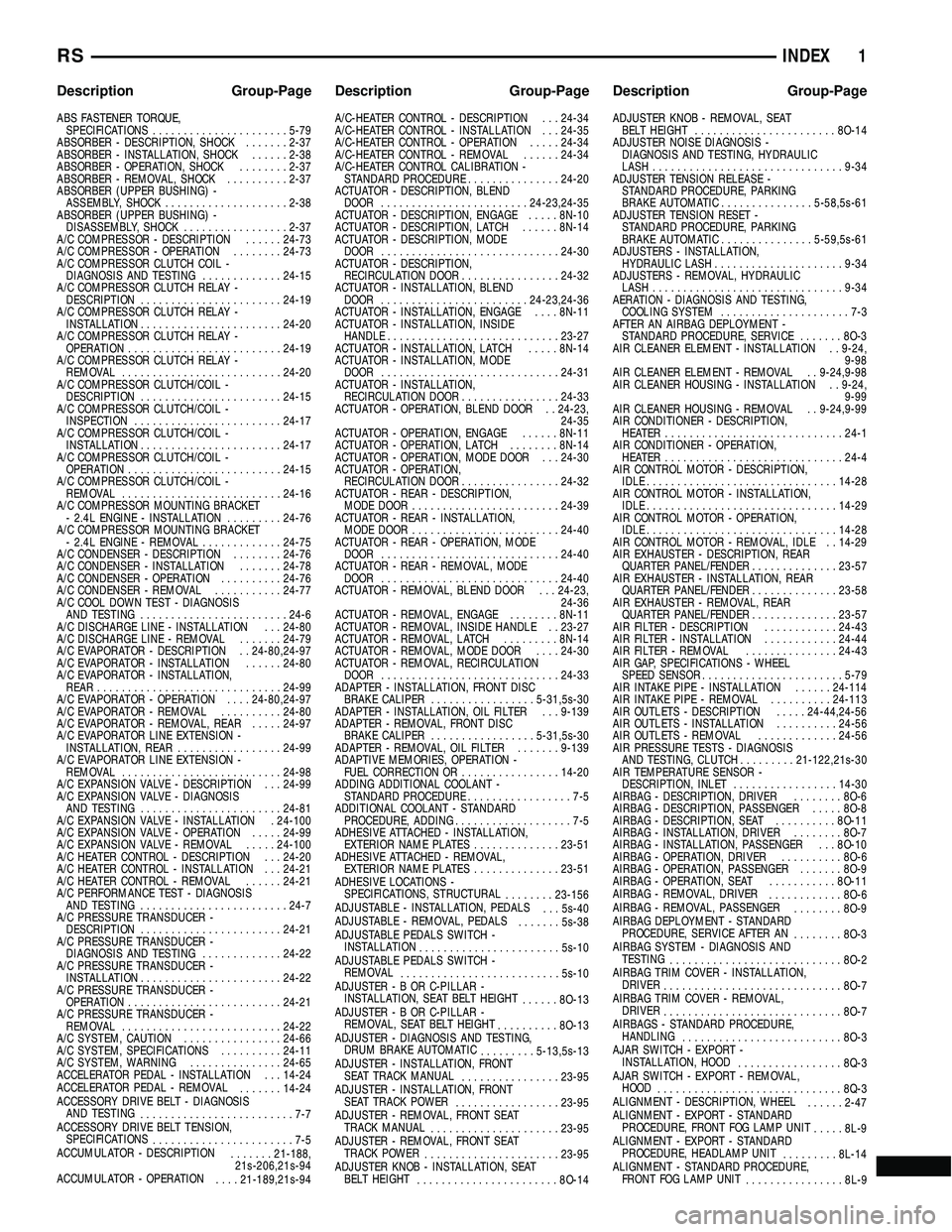
INDEX
ABS FASTENER TORQUE,
SPECIFICATIONS......................5-79
ABSORBER - DESCRIPTION, SHOCK.......2-37
ABSORBER - INSTALLATION, SHOCK......2-38
ABSORBER - OPERATION, SHOCK........2-37
ABSORBER - REMOVAL, SHOCK..........2-37
ABSORBER (UPPER BUSHING) -
ASSEMBLY, SHOCK....................2-38
ABSORBER (UPPER BUSHING) -
DISASSEMBLY, SHOCK.................2-37
A/C COMPRESSOR - DESCRIPTION......24-73
A/C COMPRESSOR - OPERATION........24-73
A/C COMPRESSOR CLUTCH COIL -
DIAGNOSIS AND TESTING.............24-15
A/C COMPRESSOR CLUTCH RELAY -
DESCRIPTION.......................24-19
A/C COMPRESSOR CLUTCH RELAY -
INSTALLATION.......................24-20
A/C COMPRESSOR CLUTCH RELAY -
OPERATION.........................24-19
A/C COMPRESSOR CLUTCH RELAY -
REMOVAL..........................24-20
A/C COMPRESSOR CLUTCH/COIL -
DESCRIPTION.......................24-15
A/C COMPRESSOR CLUTCH/COIL -
INSPECTION........................24-17
A/C COMPRESSOR CLUTCH/COIL -
INSTALLATION.......................24-17
A/C COMPRESSOR CLUTCH/COIL -
OPERATION.........................24-15
A/C COMPRESSOR CLUTCH/COIL -
REMOVAL..........................24-16
A/C COMPRESSOR MOUNTING BRACKET
- 2.4L ENGINE - INSTALLATION.........24-76
A/C COMPRESSOR MOUNTING BRACKET
- 2.4L ENGINE - REMOVAL.............24-75
A/C CONDENSER - DESCRIPTION........24-76
A/C CONDENSER - INSTALLATION.......24-78
A/C CONDENSER - OPERATION..........24-76
A/C CONDENSER - REMOVAL...........24-77
A/C COOL DOWN TEST - DIAGNOSIS
AND TESTING........................24-6
A/C DISCHARGE LINE - INSTALLATION . . . 24-80
A/C DISCHARGE LINE - REMOVAL.......24-79
A/C EVAPORATOR - DESCRIPTION . . 24-80,24-97
A/C EVAPORATOR - INSTALLATION......24-80
A/C EVAPORATOR - INSTALLATION,
REAR..............................24-99
A/C EVAPORATOR - OPERATION....24-80,24-97
A/C EVAPORATOR - REMOVAL..........24-80
A/C EVAPORATOR - REMOVAL, REAR.....24-97
A/C EVAPORATOR LINE EXTENSION -
INSTALLATION, REAR.................24-99
A/C EVAPORATOR LINE EXTENSION -
REMOVAL..........................24-98
A/C EXPANSION VALVE - DESCRIPTION . . . 24-99
A/C EXPANSION VALVE - DIAGNOSIS
AND TESTING.......................24-81
A/C EXPANSION VALVE - INSTALLATION . 24-100
A/C EXPANSION VALVE - OPERATION.....24-99
A/C EXPANSION VALVE - REMOVAL.....24-100
A/C HEATER CONTROL - DESCRIPTION . . . 24-20
A/C HEATER CONTROL - INSTALLATION . . . 24-21
A/C HEATER CONTROL - REMOVAL......24-21
A/C PERFORMANCE TEST - DIAGNOSIS
AND TESTING........................24-7
A/C PRESSURE TRANSDUCER -
DESCRIPTION.......................24-21
A/C PRESSURE TRANSDUCER -
DIAGNOSIS AND TESTING.............24-22
A/C PRESSURE TRANSDUCER -
INSTALLATION.......................24-22
A/C PRESSURE TRANSDUCER -
OPERATION.........................24-21
A/C PRESSURE TRANSDUCER -
REMOVAL..........................24-22
A/C SYSTEM, CAUTION................24-66
A/C SYSTEM, SPECIFICATIONS..........24-11
A/C SYSTEM, WARNING...............24-65
ACCELERATOR PEDAL - INSTALLATION . . . 14-24
ACCELERATOR PEDAL - REMOVAL
.......14-24
ACCESSORY DRIVE BELT - DIAGNOSIS
AND TESTING
.........................7-7
ACCESSORY DRIVE BELT TENSION,
SPECIFICATIONS
.......................7-5
ACCUMULATOR - DESCRIPTION
.......21-188,
21s-206,21s-94
ACCUMULATOR - OPERATION
....21-189,21s-94A/C-HEATER CONTROL - DESCRIPTION . . . 24-34
A/C-HEATER CONTROL - INSTALLATION . . . 24-35
A/C-HEATER CONTROL - OPERATION.....24-34
A/C-HEATER CONTROL - REMOVAL......24-34
A/C-HEATER CONTROL CALIBRATION -
STANDARD PROCEDURE...............24-20
ACTUATOR - DESCRIPTION, BLEND
DOOR........................24-23,24-35
ACTUATOR - DESCRIPTION, ENGAGE.....8N-10
ACTUATOR - DESCRIPTION, LATCH......8N-14
ACTUATOR - DESCRIPTION, MODE
DOOR.............................24-30
ACTUATOR - DESCRIPTION,
RECIRCULATION DOOR................24-32
ACTUATOR - INSTALLATION, BLEND
DOOR........................24-23,24-36
ACTUATOR - INSTALLATION, ENGAGE....8N-11
ACTUATOR - INSTALLATION, INSIDE
HANDLE............................23-27
ACTUATOR - INSTALLATION, LATCH.....8N-14
ACTUATOR - INSTALLATION, MODE
DOOR.............................24-31
ACTUATOR - INSTALLATION,
RECIRCULATION DOOR................24-33
ACTUATOR - OPERATION, BLEND DOOR . . 24-23,
24-35
ACTUATOR - OPERATION, ENGAGE......8N-11
ACTUATOR - OPERATION, LATCH........8N-14
ACTUATOR - OPERATION, MODE DOOR . . . 24-30
ACTUATOR - OPERATION,
RECIRCULATION DOOR................24-32
ACTUATOR - REAR - DESCRIPTION,
MODE DOOR........................24-39
ACTUATOR - REAR - INSTALLATION,
MODE DOOR........................24-40
ACTUATOR - REAR - OPERATION, MODE
DOOR.............................24-40
ACTUATOR - REAR - REMOVAL, MODE
DOOR.............................24-40
ACTUATOR - REMOVAL, BLEND DOOR . . . 24-23,
24-36
ACTUATOR - REMOVAL, ENGAGE........8N-11
ACTUATOR - REMOVAL, INSIDE HANDLE . . 23-27
ACTUATOR - REMOVAL, LATCH.........8N-14
ACTUATOR - REMOVAL, MODE DOOR....24-30
ACTUATOR - REMOVAL, RECIRCULATION
DOOR.............................24-33
ADAPTER - INSTALLATION, FRONT DISC
BRAKE CALIPER.................5-31,5s-30
ADAPTER - INSTALLATION, OIL FILTER . . . 9-139
ADAPTER - REMOVAL, FRONT DISC
BRAKE CALIPER.................5-31,5s-30
ADAPTER - REMOVAL, OIL FILTER.......9-139
ADAPTIVE MEMORIES, OPERATION -
FUEL CORRECTION OR................14-20
ADDING ADDITIONAL COOLANT -
STANDARD PROCEDURE.................7-5
ADDITIONAL COOLANT - STANDARD
PROCEDURE, ADDING...................7-5
ADHESIVE ATTACHED - INSTALLATION,
EXTERIOR NAME PLATES..............23-51
ADHESIVE ATTACHED - REMOVAL,
EXTERIOR NAME PLATES..............23-51
ADHESIVE LOCATIONS -
SPECIFICATIONS, STRUCTURAL
........23-156
ADJUSTABLE - INSTALLATION, PEDALS
. . . 5s-40
ADJUSTABLE - REMOVAL, PEDALS
.......5s-38
ADJUSTABLE PEDALS SWITCH -
INSTALLATION
.......................5s-10
ADJUSTABLE PEDALS SWITCH -
REMOVAL
..........................5s-10
ADJUSTER-BORC-PILLAR -
INSTALLATION, SEAT BELT HEIGHT
......8O-13
ADJUSTER-BORC-PILLAR -
REMOVAL, SEAT BELT HEIGHT
..........8O-13
ADJUSTER - DIAGNOSIS AND TESTING,
DRUM BRAKE AUTOMATIC
.........5-13,5s-13
ADJUSTER - INSTALLATION, FRONT
SEAT TRACK MANUAL
................23-95
ADJUSTER - INSTALLATION, FRONT
SEAT TRACK POWER
.................23-95
ADJUSTER - REMOVAL, FRONT SEAT
TRACK MANUAL
.....................23-95
ADJUSTER - REMOVAL, FRONT SEAT
TRACK POWER
......................23-95
ADJUSTER KNOB - INSTALLATION, SEAT
BELT HEIGHT
.......................8O-14ADJUSTER KNOB - REMOVAL, SEAT
BELT HEIGHT.......................8O-14
ADJUSTER NOISE DIAGNOSIS -
DIAGNOSIS AND TESTING, HYDRAULIC
LASH...............................9-34
ADJUSTER TENSION RELEASE -
STANDARD PROCEDURE, PARKING
BRAKE AUTOMATIC...............5-58,5s-61
ADJUSTER TENSION RESET -
STANDARD PROCEDURE, PARKING
BRAKE AUTOMATIC...............5-59,5s-61
ADJUSTERS - INSTALLATION,
HYDRAULIC LASH.....................9-34
ADJUSTERS - REMOVAL, HYDRAULIC
LASH...............................9-34
AERATION - DIAGNOSIS AND TESTING,
COOLING SYSTEM.....................7-3
AFTER AN AIRBAG DEPLOYMENT -
STANDARD PROCEDURE, SERVICE.......8O-3
AIR CLEANER ELEMENT - INSTALLATION . . 9-24,
9-98
AIR CLEANER ELEMENT - REMOVAL . . 9-24,9-98
AIR CLEANER HOUSING - INSTALLATION . . 9-24,
9-99
AIR CLEANER HOUSING - REMOVAL . . 9-24,9-99
AIR CONDITIONER - DESCRIPTION,
HEATER .............................24-1
AIR CONDITIONER - OPERATION,
HEATER .............................24-4
AIR CONTROL MOTOR - DESCRIPTION,
IDLE...............................14-28
AIR CONTROL MOTOR - INSTALLATION,
IDLE...............................14-29
AIR CONTROL MOTOR - OPERATION,
IDLE...............................14-28
AIR CONTROL MOTOR - REMOVAL, IDLE . . 14-29
AIR EXHAUSTER - DESCRIPTION, REAR
QUARTER PANEL/FENDER..............23-57
AIR EXHAUSTER - INSTALLATION, REAR
QUARTER PANEL/FENDER..............23-58
AIR EXHAUSTER - REMOVAL, REAR
QUARTER PANEL/FENDER..............23-57
AIR FILTER - DESCRIPTION............24-43
AIR FILTER - INSTALLATION............24-44
AIR FILTER - REMOVAL...............24-43
AIR GAP, SPECIFICATIONS - WHEEL
SPEED SENSOR.......................5-79
AIR INTAKE PIPE - INSTALLATION......24-114
AIR INTAKE PIPE - REMOVAL..........24-113
AIR OUTLETS - DESCRIPTION.....24-44,24-56
AIR OUTLETS - INSTALLATION..........24-56
AIR OUTLETS - REMOVAL.............24-56
AIR PRESSURE TESTS - DIAGNOSIS
AND TESTING, CLUTCH.........21-122,21s-30
AIR TEMPERATURE SENSOR -
DESCRIPTION, INLET.................14-30
AIRBAG - DESCRIPTION, DRIVER........8O-6
AIRBAG - DESCRIPTION, PASSENGER.....8O-8
AIRBAG - DESCRIPTION, SEAT..........8O-11
AIRBAG - INSTALLATION, DRIVER........8O-7
AIRBAG - INSTALLATION, PASSENGER . . . 8O-10
AIRBAG - OPERATION, DRIVER..........8O-6
AIRBAG - OPERATION, PASSENGER.......8O-9
AIRBAG - OPERATION, SEAT...........8O-11
AIRBAG - REMOVAL, DRIVER
............8O-6
AIRBAG - REMOVAL, PASSENGER
........8O-9
AIRBAG DEPLOYMENT - STANDARD
PROCEDURE, SERVICE AFTER AN
........8O-3
AIRBAG SYSTEM - DIAGNOSIS AND
TESTING
............................8O-2
AIRBAG TRIM COVER - INSTALLATION,
DRIVER
.............................8O-7
AIRBAG TRIM COVER - REMOVAL,
DRIVER
.............................8O-7
AIRBAGS - STANDARD PROCEDURE,
HANDLING
..........................8O-3
AJAR SWITCH - EXPORT -
INSTALLATION, HOOD
.................8Q-3
AJAR SWITCH - EXPORT - REMOVAL,
HOOD
..............................8Q-3
ALIGNMENT - DESCRIPTION, WHEEL
......2-47
ALIGNMENT - EXPORT - STANDARD
PROCEDURE, FRONT FOG LAMP UNIT
.....8L-9
ALIGNMENT - EXPORT - STANDARD
PROCEDURE, HEADLAMP UNIT
.........8L-14
ALIGNMENT - STANDARD PROCEDURE,
FRONT FOG LAMP UNIT
................8L-9
RSINDEX1
Description Group-Page Description Group-Page Description Group-Page
Page 2545 of 2585
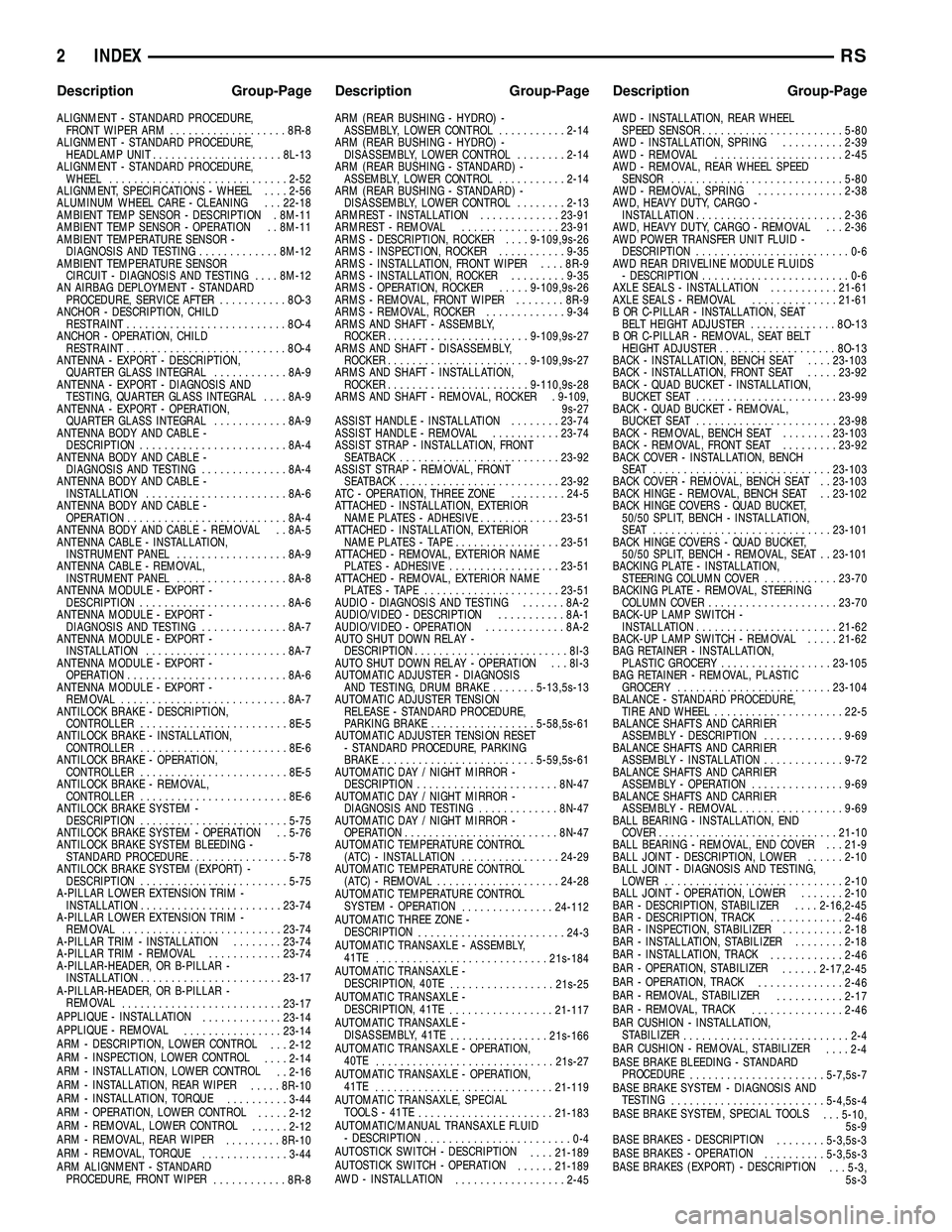
ALIGNMENT - STANDARD PROCEDURE,
FRONT WIPER ARM...................8R-8
ALIGNMENT - STANDARD PROCEDURE,
HEADLAMP UNIT.....................8L-13
ALIGNMENT - STANDARD PROCEDURE,
WHEEL.............................2-52
ALIGNMENT, SPECIFICATIONS - WHEEL....2-56
ALUMINUM WHEEL CARE - CLEANING . . . 22-18
AMBIENT TEMP SENSOR - DESCRIPTION . 8M-11
AMBIENT TEMP SENSOR - OPERATION . . 8M-11
AMBIENT TEMPERATURE SENSOR -
DIAGNOSIS AND TESTING.............8M-12
AMBIENT TEMPERATURE SENSOR
CIRCUIT - DIAGNOSIS AND TESTING....8M-12
AN AIRBAG DEPLOYMENT - STANDARD
PROCEDURE, SERVICE AFTER...........8O-3
ANCHOR - DESCRIPTION, CHILD
RESTRAINT..........................8O-4
ANCHOR - OPERATION, CHILD
RESTRAINT..........................8O-4
ANTENNA - EXPORT - DESCRIPTION,
QUARTER GLASS INTEGRAL............8A-9
ANTENNA - EXPORT - DIAGNOSIS AND
TESTING, QUARTER GLASS INTEGRAL....8A-9
ANTENNA - EXPORT - OPERATION,
QUARTER GLASS INTEGRAL............8A-9
ANTENNA BODY AND CABLE -
DESCRIPTION........................8A-4
ANTENNA BODY AND CABLE -
DIAGNOSIS AND TESTING..............8A-4
ANTENNA BODY AND CABLE -
INSTALLATION.......................8A-6
ANTENNA BODY AND CABLE -
OPERATION..........................8A-4
ANTENNA BODY AND CABLE - REMOVAL . . 8A-5
ANTENNA CABLE - INSTALLATION,
INSTRUMENT PANEL..................8A-9
ANTENNA CABLE - REMOVAL,
INSTRUMENT PANEL..................8A-8
ANTENNA MODULE - EXPORT -
DESCRIPTION........................8A-6
ANTENNA MODULE - EXPORT -
DIAGNOSIS AND TESTING..............8A-7
ANTENNA MODULE - EXPORT -
INSTALLATION.......................8A-7
ANTENNA MODULE - EXPORT -
OPERATION..........................8A-6
ANTENNA MODULE - EXPORT -
REMOVAL...........................8A-7
ANTILOCK BRAKE - DESCRIPTION,
CONTROLLER........................8E-5
ANTILOCK BRAKE - INSTALLATION,
CONTROLLER........................8E-6
ANTILOCK BRAKE - OPERATION,
CONTROLLER........................8E-5
ANTILOCK BRAKE - REMOVAL,
CONTROLLER........................8E-6
ANTILOCK BRAKE SYSTEM -
DESCRIPTION........................5-75
ANTILOCK BRAKE SYSTEM - OPERATION . . 5-76
ANTILOCK BRAKE SYSTEM BLEEDING -
STANDARD PROCEDURE................5-78
ANTILOCK BRAKE SYSTEM (EXPORT) -
DESCRIPTION........................5-75
A-PILLAR LOWER EXTENSION TRIM -
INSTALLATION.......................23-74
A-PILLAR LOWER EXTENSION TRIM -
REMOVAL..........................23-74
A-PILLAR TRIM - INSTALLATION........23-74
A-PILLAR TRIM - REMOVAL............23-74
A-PILLAR-HEADER, OR B-PILLAR -
INSTALLATION.......................23-17
A-PILLAR-HEADER, OR B-PILLAR -
REMOVAL
..........................23-17
APPLIQUE - INSTALLATION
.............23-14
APPLIQUE - REMOVAL
................23-14
ARM - DESCRIPTION, LOWER CONTROL
. . . 2-12
ARM - INSPECTION, LOWER CONTROL
....2-14
ARM - INSTALLATION, LOWER CONTROL
. . 2-16
ARM - INSTALLATION, REAR WIPER
.....8R-10
ARM - INSTALLATION, TORQUE
..........3-44
ARM - OPERATION, LOWER CONTROL
.....2-12
ARM - REMOVAL, LOWER CONTROL
......2-12
ARM - REMOVAL, REAR WIPER
.........8R-10
ARM - REMOVAL, TORQUE
..............3-44
ARM ALIGNMENT - STANDARD
PROCEDURE, FRONT WIPER
............8R-8ARM (REAR BUSHING - HYDRO) -
ASSEMBLY, LOWER CONTROL...........2-14
ARM (REAR BUSHING - HYDRO) -
DISASSEMBLY, LOWER CONTROL........2-14
ARM (REAR BUSHING - STANDARD) -
ASSEMBLY, LOWER CONTROL...........2-14
ARM (REAR BUSHING - STANDARD) -
DISASSEMBLY, LOWER CONTROL........2-13
ARMREST - INSTALLATION.............23-91
ARMREST - REMOVAL................23-91
ARMS - DESCRIPTION, ROCKER....9-109,9s-26
ARMS - INSPECTION, ROCKER...........9-35
ARMS - INSTALLATION, FRONT WIPER....8R-9
ARMS - INSTALLATION, ROCKER.........9-35
ARMS - OPERATION, ROCKER.....9-109,9s-26
ARMS - REMOVAL, FRONT WIPER........8R-9
ARMS - REMOVAL, ROCKER.............9-34
ARMS AND SHAFT - ASSEMBLY,
ROCKER.......................9-109,9s-27
ARMS AND SHAFT - DISASSEMBLY,
ROCKER.......................9-109,9s-27
ARMS AND SHAFT - INSTALLATION,
ROCKER.......................9-110,9s-28
ARMS AND SHAFT - REMOVAL, ROCKER . 9-109,
9s-27
ASSIST HANDLE - INSTALLATION........23-74
ASSIST HANDLE - REMOVAL...........23-74
ASSIST STRAP - INSTALLATION, FRONT
SEATBACK..........................23-92
ASSIST STRAP - REMOVAL, FRONT
SEATBACK..........................23-92
ATC - OPERATION, THREE ZONE.........24-5
ATTACHED - INSTALLATION, EXTERIOR
NAME PLATES - ADHESIVE.............23-51
ATTACHED - INSTALLATION, EXTERIOR
NAME PLATES - TAPE.................23-51
ATTACHED - REMOVAL, EXTERIOR NAME
PLATES - ADHESIVE..................23-51
ATTACHED - REMOVAL, EXTERIOR NAME
PLATES - TAPE ......................23-51
AUDIO - DIAGNOSIS AND TESTING.......8A-2
AUDIO/VIDEO - DESCRIPTION...........8A-1
AUDIO/VIDEO - OPERATION.............8A-2
AUTO SHUT DOWN RELAY -
DESCRIPTION.........................8I-3
AUTO SHUT DOWN RELAY - OPERATION . . . 8I-3
AUTOMATIC ADJUSTER - DIAGNOSIS
AND TESTING, DRUM BRAKE.......5-13,5s-13
AUTOMATIC ADJUSTER TENSION
RELEASE - STANDARD PROCEDURE,
PARKING BRAKE.................5-58,5s-61
AUTOMATIC ADJUSTER TENSION RESET
- STANDARD PROCEDURE, PARKING
BRAKE.........................5-59,5s-61
AUTOMATIC DAY / NIGHT MIRROR -
DESCRIPTION.......................8N-47
AUTOMATIC DAY / NIGHT MIRROR -
DIAGNOSIS AND TESTING.............8N-47
AUTOMATIC DAY / NIGHT MIRROR -
OPERATION.........................8N-47
AUTOMATIC TEMPERATURE CONTROL
(ATC) - INSTALLATION................24-29
AUTOMATIC TEMPERATURE CONTROL
(ATC) - REMOVAL....................24-28
AUTOMATIC TEMPERATURE CONTROL
SYSTEM - OPERATION
...............24-112
AUTOMATIC THREE ZONE -
DESCRIPTION
........................24-3
AUTOMATIC TRANSAXLE - ASSEMBLY,
41TE
............................21s-184
AUTOMATIC TRANSAXLE -
DESCRIPTION, 40TE
.................21s-25
AUTOMATIC TRANSAXLE -
DESCRIPTION, 41TE
.................21-117
AUTOMATIC TRANSAXLE -
DISASSEMBLY, 41TE
................21s-166
AUTOMATIC TRANSAXLE - OPERATION,
40TE
.............................21s-27
AUTOMATIC TRANSAXLE - OPERATION,
41TE
.............................21-119
AUTOMATIC TRANSAXLE, SPECIAL
TOOLS - 41TE
......................21-183
AUTOMATIC/MANUAL TRANSAXLE FLUID
- DESCRIPTION
........................0-4
AUTOSTICK SWITCH - DESCRIPTION
....21-189
AUTOSTICK SWITCH - OPERATION
......21-189
AWD - INSTALLATION
..................2-45AWD - INSTALLATION, REAR WHEEL
SPEED SENSOR.......................5-80
AWD - INSTALLATION, SPRING..........2-39
AWD - REMOVAL.....................2-45
AWD - REMOVAL, REAR WHEEL SPEED
SENSOR............................5-80
AWD - REMOVAL, SPRING..............2-38
AWD, HEAVY DUTY, CARGO -
INSTALLATION........................2-36
AWD, HEAVY DUTY, CARGO - REMOVAL . . . 2-36
AWD POWER TRANSFER UNIT FLUID -
DESCRIPTION.........................0-6
AWD REAR DRIVELINE MODULE FLUIDS
- DESCRIPTION........................0-6
AXLE SEALS - INSTALLATION...........21-61
AXLE SEALS - REMOVAL..............21-61
B OR C-PILLAR - INSTALLATION, SEAT
BELT HEIGHT ADJUSTER..............8O-13
B OR C-PILLAR - REMOVAL, SEAT BELT
HEIGHT ADJUSTER...................8O-13
BACK - INSTALLATION, BENCH SEAT....23-103
BACK - INSTALLATION, FRONT SEAT.....23-92
BACK - QUAD BUCKET - INSTALLATION,
BUCKET SEAT.......................23-99
BACK - QUAD BUCKET - REMOVAL,
BUCKET SEAT.......................23-98
BACK - REMOVAL, BENCH SEAT........23-103
BACK - REMOVAL, FRONT SEAT.........23-92
BACK COVER - INSTALLATION, BENCH
SEAT .............................23-103
BACK COVER - REMOVAL, BENCH SEAT . . 23-103
BACK HINGE - REMOVAL, BENCH SEAT . . 23-102
BACK HINGE COVERS - QUAD BUCKET,
50/50 SPLIT, BENCH - INSTALLATION,
SEAT .............................23-101
BACK HINGE COVERS - QUAD BUCKET,
50/50 SPLIT, BENCH - REMOVAL, SEAT . . 23-101
BACKING PLATE - INSTALLATION,
STEERING COLUMN COVER............23-70
BACKING PLATE - REMOVAL, STEERING
COLUMN COVER.....................23-70
BACK-UP LAMP SWITCH -
INSTALLATION.......................21-62
BACK-UP LAMP SWITCH - REMOVAL.....21-62
BAG RETAINER - INSTALLATION,
PLASTIC GROCERY..................23-105
BAG RETAINER - REMOVAL, PLASTIC
GROCERY.........................23-104
BALANCE - STANDARD PROCEDURE,
TIRE AND WHEEL.....................22-5
BALANCE SHAFTS AND CARRIER
ASSEMBLY - DESCRIPTION.............9-69
BALANCE SHAFTS AND CARRIER
ASSEMBLY - INSTALLATION.............9-72
BALANCE SHAFTS AND CARRIER
ASSEMBLY - OPERATION...............9-69
BALANCE SHAFTS AND CARRIER
ASSEMBLY - REMOVAL.................9-69
BALL BEARING - INSTALLATION, END
COVER.............................21-10
BALL BEARING - REMOVAL, END COVER . . . 21-9
BALL JOINT - DESCRIPTION, LOWER......2-10
BALL JOINT - DIAGNOSIS AND TESTING,
LOWER.............................2-10
BALL JOINT - OPERATION, LOWER.......2-10
BAR - DESCRIPTION, STABILIZER....2-16,2-45
BAR - DESCRIPTION, TRACK............2-46
BAR - INSPECTION, STABILIZER..........2-18
BAR - INSTALLATION, STABILIZER........2-18
BAR - INSTALLATION, TRACK
............2-46
BAR - OPERATION, STABILIZER
......2-17,2-45
BAR - OPERATION, TRACK
..............2-46
BAR - REMOVAL, STABILIZER
...........2-17
BAR - REMOVAL, TRACK
...............2-46
BAR CUSHION - INSTALLATION,
STABILIZER
...........................2-4
BAR CUSHION - REMOVAL, STABILIZER
....2-4
BASE BRAKE BLEEDING - STANDARD
PROCEDURE
......................5-7,5s-7
BASE BRAKE SYSTEM - DIAGNOSIS AND
TESTING
.........................5-4,5s-4
BASE BRAKE SYSTEM, SPECIAL TOOLS
. . . 5-10,
5s-9
BASE BRAKES - DESCRIPTION
........5-3,5s-3
BASE BRAKES - OPERATION
..........5-3,5s-3
BASE BRAKES (EXPORT) - DESCRIPTION
. . . 5-3,
5s-3
2 INDEXRS
Description Group-Page Description Group-Page Description Group-Page